Hearty Beef Stew Recipe: A Cozy Comfort Food Classic
Crafting a hearty beef stew that warms your soul brings pure comfort on chilly evenings.
Aromatic herbs and tender meat create a magical culinary experience.
Slow-cooking transforms simple ingredients into a rich, mouth-watering dish that feels like a warm embrace.
Layers of flavor develop gradually, infusing each bite with deep, satisfying notes.
Kitchen wisdom passed through generations makes this recipe special and deeply personal.
Robust chunks of meat and vegetables simmer together, creating a symphony of tastes.
You’ll find this stew becomes an instant classic at your dinner table.
The Appeal Of Classic Beef Stew
Ingredients To Gather For Beef Stew
Main Ingredients:Vegetables:Seasonings and Flavor Enhancers:Instructions For Making Beef Stew
Step 1: Prepare Beef Cubes
Grab your beef and give it a flavor boost by sprinkling salt and pepper all over. Next, roll each beef piece in flour, creating a light, crispy coating that’ll help thicken the stew and add amazing texture.
Step 2: Brown the Meat
Fire up a large pot with olive oil over medium heat. Carefully place beef cubes into the hot pan, letting each side develop a gorgeous golden-brown crust.
Once beautifully seared, transfer the meat to a separate plate.
Step 3: Create Flavor Base
In the same pot with all those delicious meat drippings, toss in:Sauté these veggies until they become soft and start releasing their sweet, aromatic flavors.
Step 4: Build the Stew Liquid
Introduce these flavor-packed ingredients to the pot:Slide the browned beef back into the pot. Bring everything to a rolling boil, then reduce heat and let it gently simmer.
Cook for 1.5 to 2 hours until the meat becomes melt-in-your-mouth tender.
Step 5: Add Hearty Potatoes
During the final 30 minutes of cooking, drop in cubed potatoes.
Let them cook until they’re perfectly soft and ready to soak up all the rich, savory broth.
Step 6: Serve and Enjoy
Pluck out the bay leaves and thyme sprigs.
Ladle this comforting stew into bowls and pair with your favorite side dishes. Get ready for a meal that’ll warm your soul!
Tips For Cooking The Perfect Beef Stew
Variations On Classic Beef Stew
What Goes Well With Beef Stew
Best Ways To Store Beef Stew
FAQs
Dredging helps create a golden-brown crust and thickens the stew sauce, adding rich flavor and helping the meat brown evenly.
Chuck roast or stew meat works best because they have enough fat and connective tissue to become tender during slow cooking.
The beef should easily break apart with a fork and feel soft after 1.5-2 hours of simmering, indicating it’s perfectly tender.
Yes, searing locks in flavor, creates a delicious caramelized exterior, and develops a deeper, more complex taste for the stew.
Print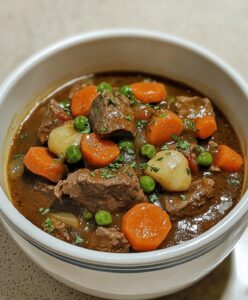
Classic Beef Stew Recipe
- Total Time: 1 hour 50 minutes
- Yield: 6 1x
Description
Hearty Irish beef stew simmers with tender meat, root vegetables, and Guinness-infused broth. Comforting flavors meld together, creating a soul-warming dish you’ll savor with each spoonful.
Ingredients
Meat:
- 2 pounds beef chuck (cubed)
Vegetables:
- 4 medium potatoes (peeled and cubed)
- 3 carrots (sliced)
- 2 celery stalks (sliced)
- 1 onion (diced)
- 3 garlic cloves (minced)
Seasonings and Liquids:
- 4 cups beef broth
- 2 tablespoons tomato paste
- 1/4 cup all-purpose flour
- 2 tablespoons olive oil
- 2 tablespoons worcestershire sauce
- 2 bay leaves
- 1 teaspoon thyme (fresh or dried)
- Salt (to taste)
- Black pepper (to taste)
Instructions
- Prepare the beef by coating each cube with seasoned flour, ensuring an even, light dusting that will help create a rich, golden crust during searing.
- Heat olive oil in a heavy-bottomed pot over medium-high heat until shimmering. Carefully place floured beef cubes into the hot pan, allowing each piece to develop a deep, caramelized exterior without overcrowding.
- Transfer browned meat to a plate, leaving behind flavorful browned bits at the bottom of the pot. Add chopped onions, minced garlic, diced carrots, and sliced celery, stirring frequently until vegetables become translucent and slightly softened.
- Deglaze the pot with beef broth, scraping up the concentrated flavor deposits. Incorporate tomato paste, Worcestershire sauce, bay leaves, and fresh thyme, creating a robust aromatic base.
- Return seared beef to the pot, submerging the meat completely in the liquid. Bring the mixture to a gentle boil, then reduce heat to low, covering and allowing the stew to simmer for approximately 1.5 hours at 325°F.
- During the final 30 minutes of cooking, introduce cubed potatoes, ensuring they become tender but not mushy. Stir occasionally to prevent sticking and promote even cooking.
- Once meat is fork-tender and potatoes are soft, remove bay leaves and thyme sprigs. Taste and adjust seasoning if needed before serving in warm bowls alongside crusty bread or rice.
Notes
- Choose tough, marbled cuts like chuck roast for maximum flavor and tenderness in your beef stew.
- Pat beef cubes completely dry before seasoning to ensure perfect browning and develop rich caramelized exterior.
- Use a heavy-bottomed Dutch oven or cast-iron pot to distribute heat evenly and prevent burning during searing and simmering.
- Customize the stew by adding red wine or dark beer instead of some beef broth for deeper, more complex flavor profile.
- Make this dish gluten-free by substituting all-purpose flour with cornstarch or gluten-free flour blend when dredging beef.
- Enhance nutritional value by incorporating additional root vegetables like parsnips or turnips during the last 30 minutes of cooking.
- Prep Time: 20 minutes
- Cook Time: 1 hour 30 minutes
- Category: Lunch, Dinner
- Method: Simmering
- Cuisine: American
Nutrition
- Serving Size: 6
- Calories: 280 kcal
- Sugar: 3 g
- Sodium: 450 mg
- Fat: 12 g
- Saturated Fat: 4 g
- Unsaturated Fat: 7 g
- Trans Fat: 0.2 g
- Carbohydrates: 20 g
- Fiber: 3 g
- Protein: 25 g
- Cholesterol: 75 mg

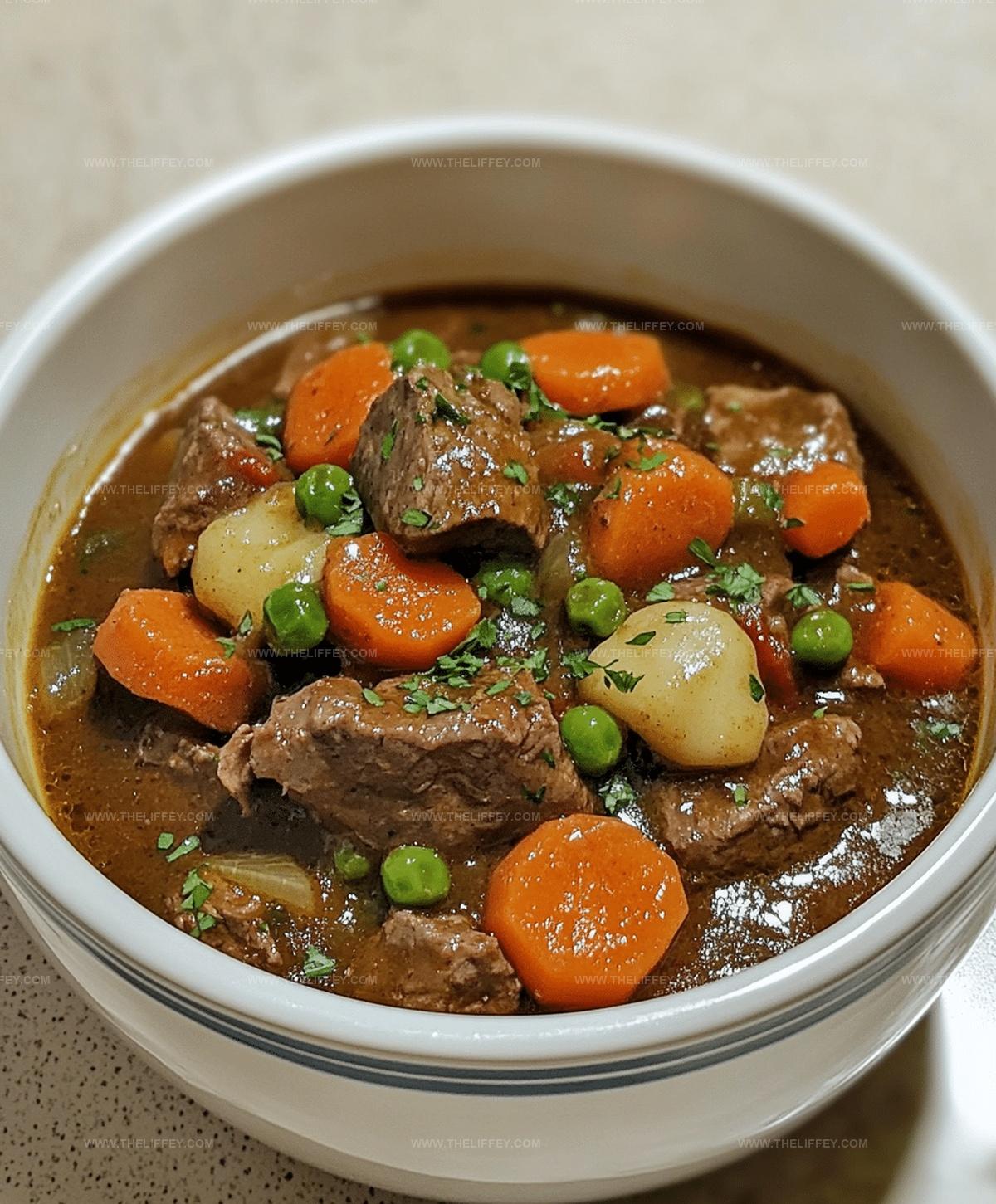
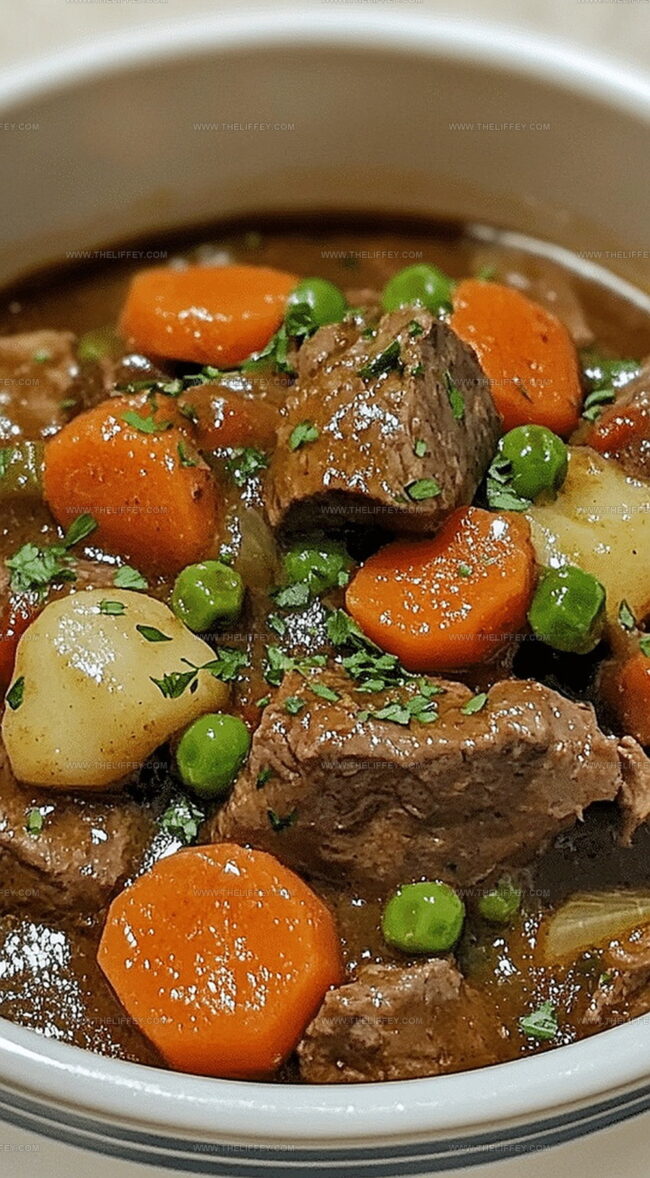
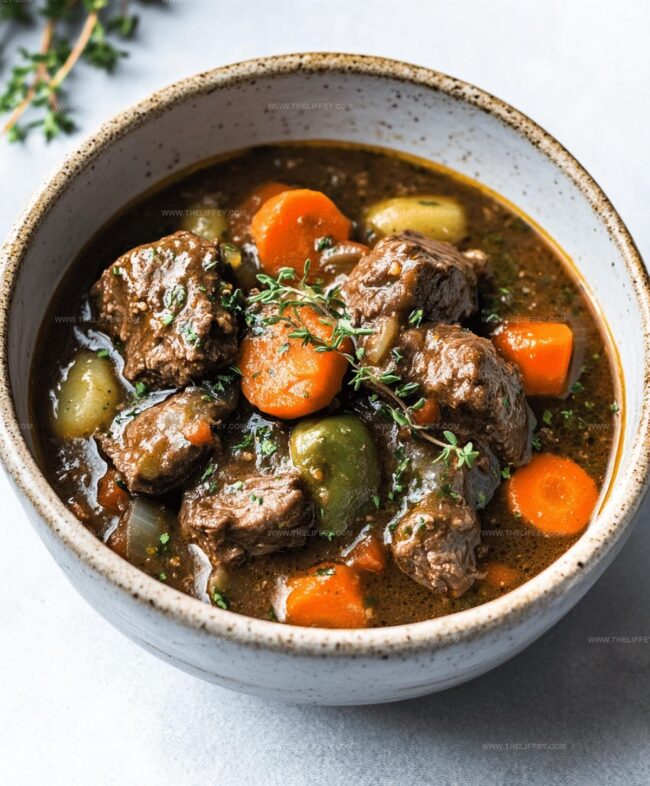
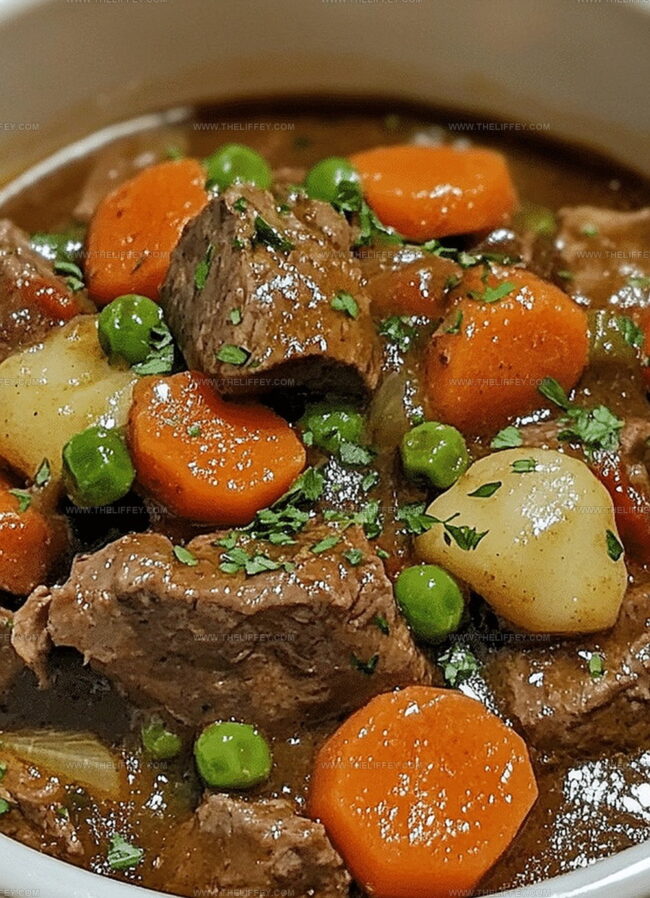
John Conley
Founder & Culinary Storyteller
Expertise
Recipe Development, Culinary Writing, Home Cooking Techniques, Seasonal Ingredient Utilization
Education
Lane Community College, Eugene, OR
Certificate in Culinary Arts
Focused on foundational cooking techniques, kitchen safety, and menu planning.
Gotham Writers Workshop, New York, NY
Course in Food Writing
Explored the art of crafting engaging culinary narratives and recipe development.
John grew up where food meant connection: big bowls, warm kitchens, and meals that told a story. After earning his Certificate in Culinary Arts from Lane Community College and diving deep into food writing at Gotham Writers Workshop, he found his calling: turning everyday recipes into something worth savoring.
At The Liffey, John’s focus is all about crafting dishes that feel easy, honest, and full of heart.